Investigating the Effect of Asymmetric Bearing Stiffness on Vibration
VerifiedAdded on 2023/06/09
|20
|4585
|404
Report
AI Summary
This report explores the effect of asymmetric bearing stiffness on the shaft vibration orbit, emphasizing the significance of understanding vibration in rotating machinery. It covers key aspects such as the concept of vibration, its causes (including unbalance, cracks, and misalignment), and the importance of vibration analysis in preventing machine failures. The study outlines the objectives, which include assessing the impact of asymmetric bearing stiffness on shaft vibration, and discusses various types of vibrations (free, forced, damped, and undamped) and factors influencing vibration rates, such as amplitude, damping, and spring constant. The literature review highlights different types of vibrations and their causes, including shaft misalignment, imbalance vibration, and shaft crank, providing a comprehensive background for the research questions.
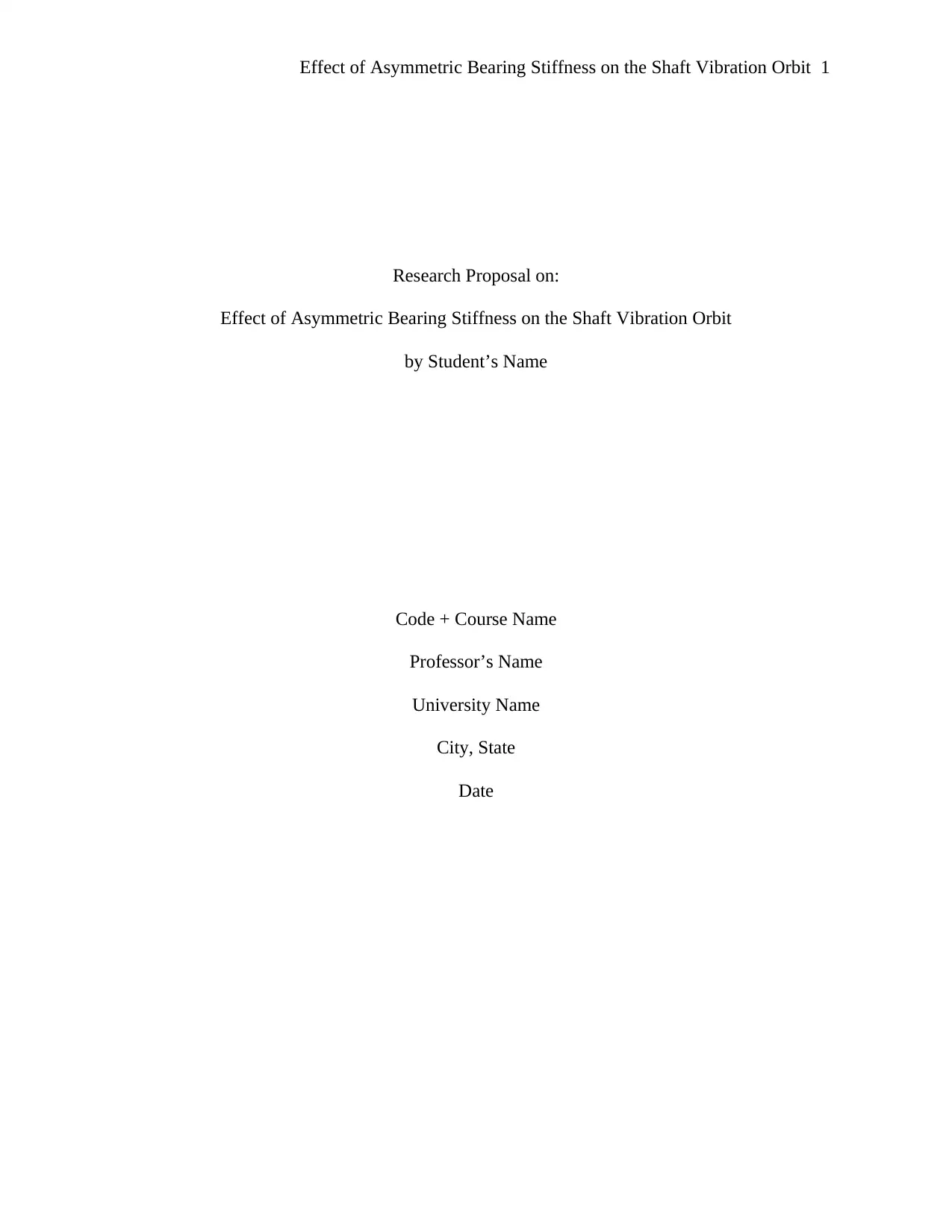
Effect of Asymmetric Bearing Stiffness on the Shaft Vibration Orbit 1
Research Proposal on:
Effect of Asymmetric Bearing Stiffness on the Shaft Vibration Orbit
by Student’s Name
Code + Course Name
Professor’s Name
University Name
City, State
Date
Research Proposal on:
Effect of Asymmetric Bearing Stiffness on the Shaft Vibration Orbit
by Student’s Name
Code + Course Name
Professor’s Name
University Name
City, State
Date
Paraphrase This Document
Need a fresh take? Get an instant paraphrase of this document with our AI Paraphraser
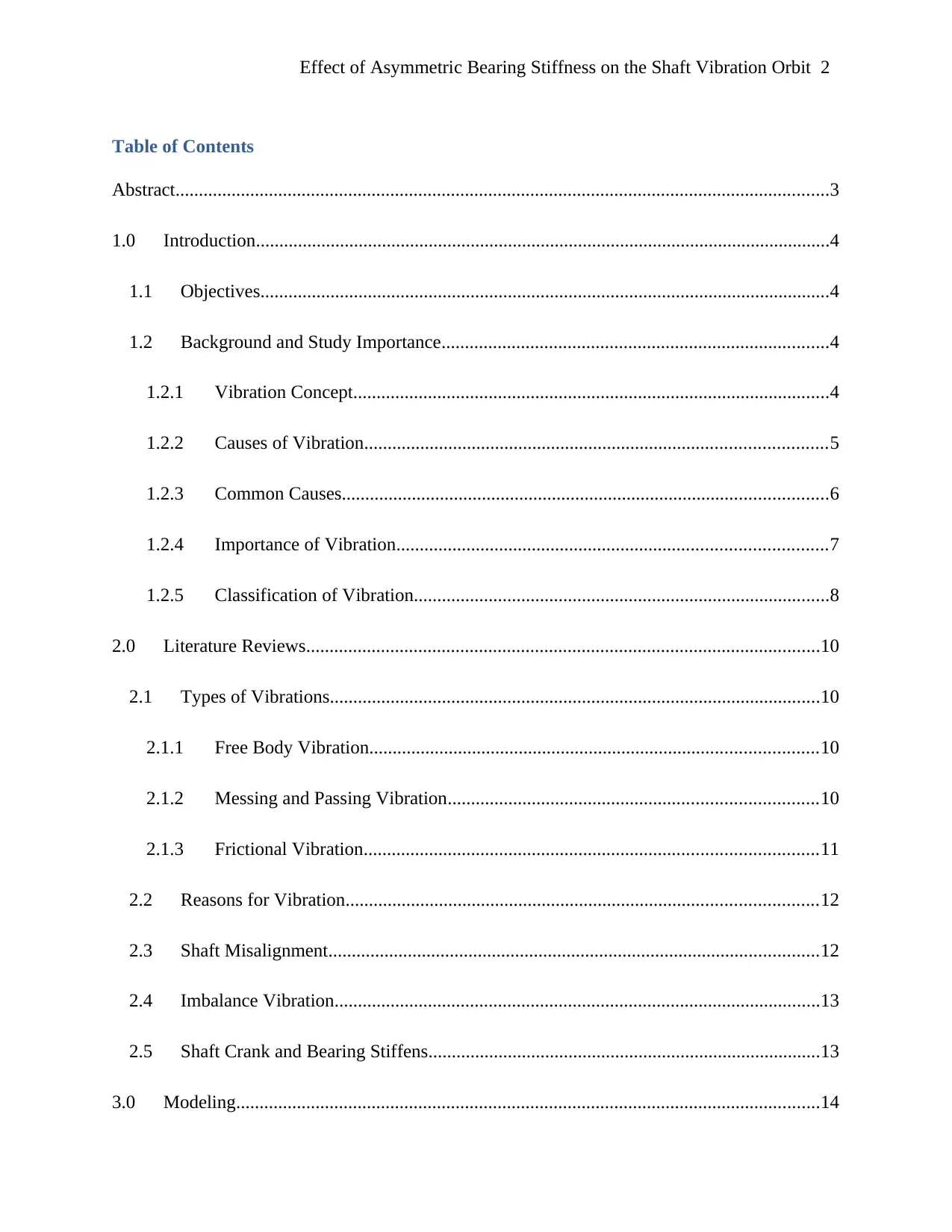
Effect of Asymmetric Bearing Stiffness on the Shaft Vibration Orbit 2
Table of Contents
Abstract............................................................................................................................................3
1.0 Introduction...........................................................................................................................4
1.1 Objectives..........................................................................................................................4
1.2 Background and Study Importance...................................................................................4
1.2.1 Vibration Concept......................................................................................................4
1.2.2 Causes of Vibration...................................................................................................5
1.2.3 Common Causes........................................................................................................6
1.2.4 Importance of Vibration............................................................................................7
1.2.5 Classification of Vibration.........................................................................................8
2.0 Literature Reviews..............................................................................................................10
2.1 Types of Vibrations.........................................................................................................10
2.1.1 Free Body Vibration................................................................................................10
2.1.2 Messing and Passing Vibration...............................................................................10
2.1.3 Frictional Vibration.................................................................................................11
2.2 Reasons for Vibration.....................................................................................................12
2.3 Shaft Misalignment.........................................................................................................12
2.4 Imbalance Vibration........................................................................................................13
2.5 Shaft Crank and Bearing Stiffens....................................................................................13
3.0 Modeling.............................................................................................................................14
Table of Contents
Abstract............................................................................................................................................3
1.0 Introduction...........................................................................................................................4
1.1 Objectives..........................................................................................................................4
1.2 Background and Study Importance...................................................................................4
1.2.1 Vibration Concept......................................................................................................4
1.2.2 Causes of Vibration...................................................................................................5
1.2.3 Common Causes........................................................................................................6
1.2.4 Importance of Vibration............................................................................................7
1.2.5 Classification of Vibration.........................................................................................8
2.0 Literature Reviews..............................................................................................................10
2.1 Types of Vibrations.........................................................................................................10
2.1.1 Free Body Vibration................................................................................................10
2.1.2 Messing and Passing Vibration...............................................................................10
2.1.3 Frictional Vibration.................................................................................................11
2.2 Reasons for Vibration.....................................................................................................12
2.3 Shaft Misalignment.........................................................................................................12
2.4 Imbalance Vibration........................................................................................................13
2.5 Shaft Crank and Bearing Stiffens....................................................................................13
3.0 Modeling.............................................................................................................................14
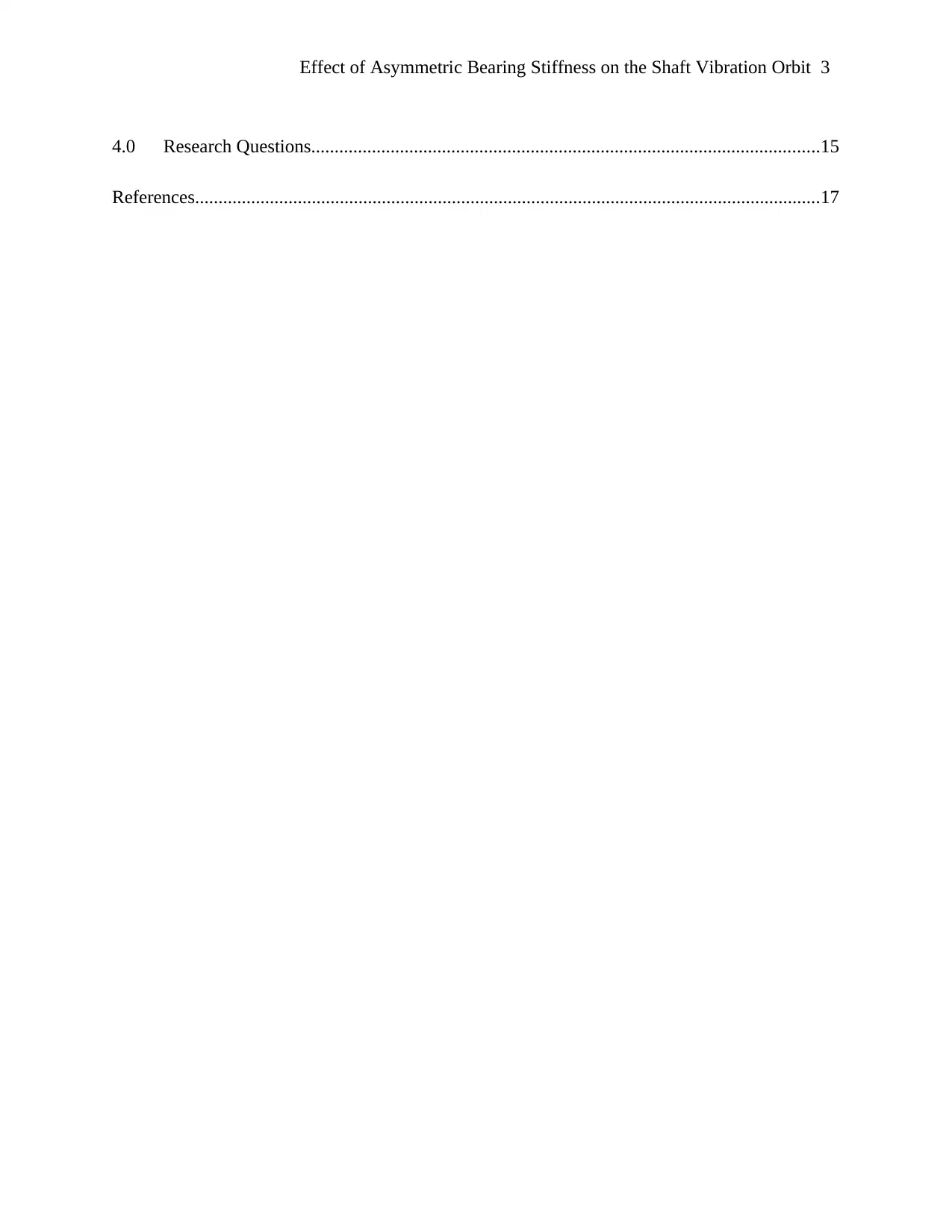
Effect of Asymmetric Bearing Stiffness on the Shaft Vibration Orbit 3
4.0 Research Questions.............................................................................................................15
References......................................................................................................................................17
4.0 Research Questions.............................................................................................................15
References......................................................................................................................................17
⊘ This is a preview!⊘
Do you want full access?
Subscribe today to unlock all pages.

Trusted by 1+ million students worldwide
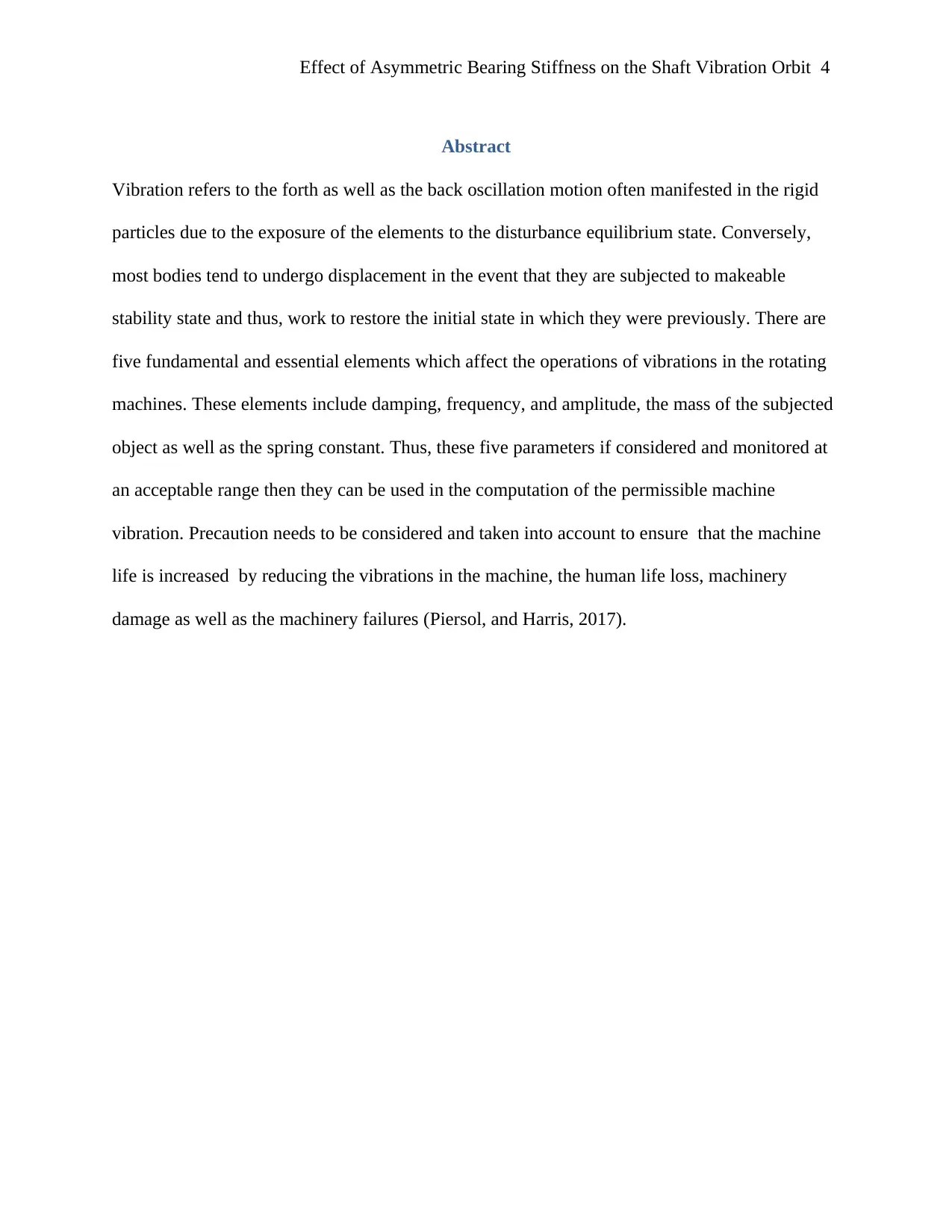
Effect of Asymmetric Bearing Stiffness on the Shaft Vibration Orbit 4
Abstract
Vibration refers to the forth as well as the back oscillation motion often manifested in the rigid
particles due to the exposure of the elements to the disturbance equilibrium state. Conversely,
most bodies tend to undergo displacement in the event that they are subjected to makeable
stability state and thus, work to restore the initial state in which they were previously. There are
five fundamental and essential elements which affect the operations of vibrations in the rotating
machines. These elements include damping, frequency, and amplitude, the mass of the subjected
object as well as the spring constant. Thus, these five parameters if considered and monitored at
an acceptable range then they can be used in the computation of the permissible machine
vibration. Precaution needs to be considered and taken into account to ensure that the machine
life is increased by reducing the vibrations in the machine, the human life loss, machinery
damage as well as the machinery failures (Piersol, and Harris, 2017).
Abstract
Vibration refers to the forth as well as the back oscillation motion often manifested in the rigid
particles due to the exposure of the elements to the disturbance equilibrium state. Conversely,
most bodies tend to undergo displacement in the event that they are subjected to makeable
stability state and thus, work to restore the initial state in which they were previously. There are
five fundamental and essential elements which affect the operations of vibrations in the rotating
machines. These elements include damping, frequency, and amplitude, the mass of the subjected
object as well as the spring constant. Thus, these five parameters if considered and monitored at
an acceptable range then they can be used in the computation of the permissible machine
vibration. Precaution needs to be considered and taken into account to ensure that the machine
life is increased by reducing the vibrations in the machine, the human life loss, machinery
damage as well as the machinery failures (Piersol, and Harris, 2017).
Paraphrase This Document
Need a fresh take? Get an instant paraphrase of this document with our AI Paraphraser
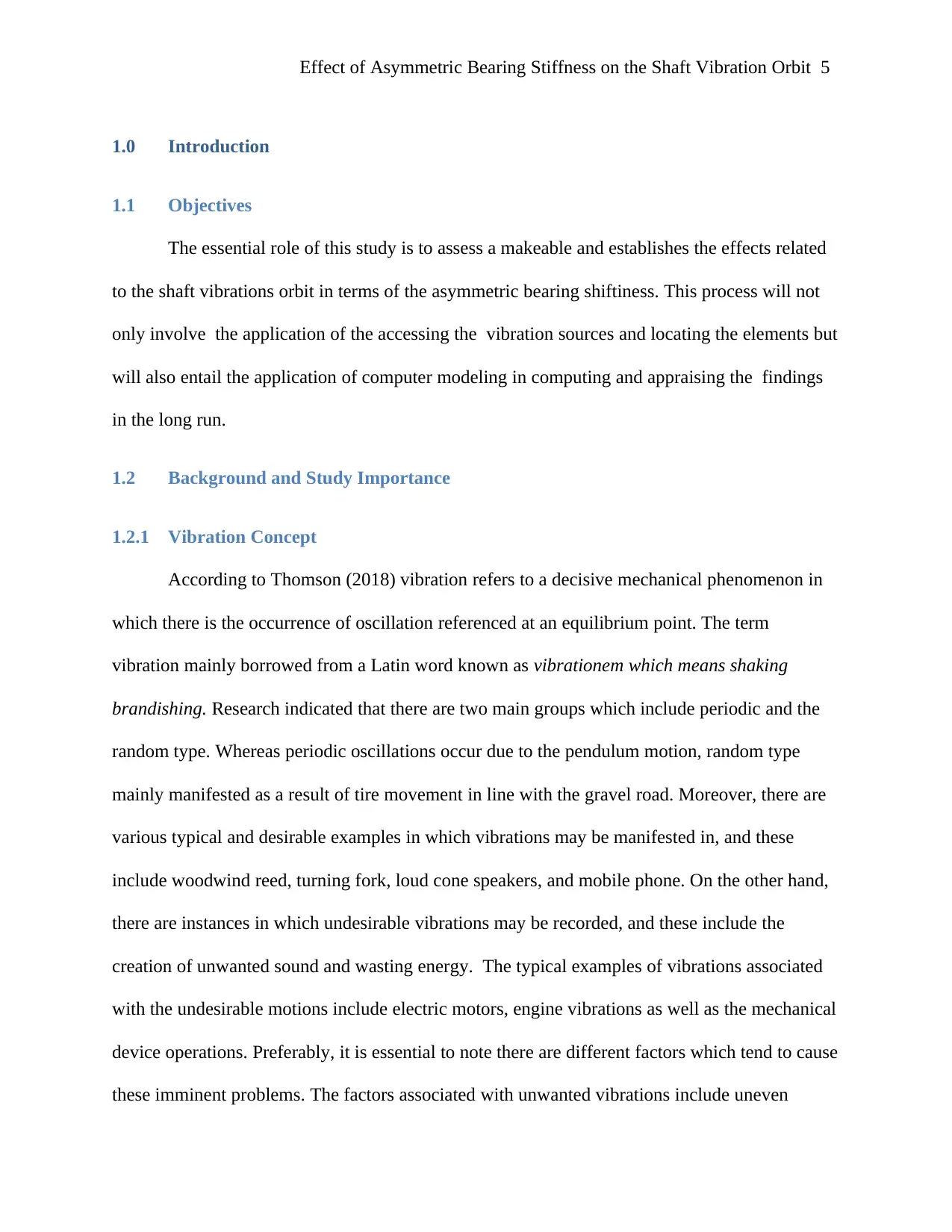
Effect of Asymmetric Bearing Stiffness on the Shaft Vibration Orbit 5
1.0 Introduction
1.1 Objectives
The essential role of this study is to assess a makeable and establishes the effects related
to the shaft vibrations orbit in terms of the asymmetric bearing shiftiness. This process will not
only involve the application of the accessing the vibration sources and locating the elements but
will also entail the application of computer modeling in computing and appraising the findings
in the long run.
1.2 Background and Study Importance
1.2.1 Vibration Concept
According to Thomson (2018) vibration refers to a decisive mechanical phenomenon in
which there is the occurrence of oscillation referenced at an equilibrium point. The term
vibration mainly borrowed from a Latin word known as vibrationem which means shaking
brandishing. Research indicated that there are two main groups which include periodic and the
random type. Whereas periodic oscillations occur due to the pendulum motion, random type
mainly manifested as a result of tire movement in line with the gravel road. Moreover, there are
various typical and desirable examples in which vibrations may be manifested in, and these
include woodwind reed, turning fork, loud cone speakers, and mobile phone. On the other hand,
there are instances in which undesirable vibrations may be recorded, and these include the
creation of unwanted sound and wasting energy. The typical examples of vibrations associated
with the undesirable motions include electric motors, engine vibrations as well as the mechanical
device operations. Preferably, it is essential to note there are different factors which tend to cause
these imminent problems. The factors associated with unwanted vibrations include uneven
1.0 Introduction
1.1 Objectives
The essential role of this study is to assess a makeable and establishes the effects related
to the shaft vibrations orbit in terms of the asymmetric bearing shiftiness. This process will not
only involve the application of the accessing the vibration sources and locating the elements but
will also entail the application of computer modeling in computing and appraising the findings
in the long run.
1.2 Background and Study Importance
1.2.1 Vibration Concept
According to Thomson (2018) vibration refers to a decisive mechanical phenomenon in
which there is the occurrence of oscillation referenced at an equilibrium point. The term
vibration mainly borrowed from a Latin word known as vibrationem which means shaking
brandishing. Research indicated that there are two main groups which include periodic and the
random type. Whereas periodic oscillations occur due to the pendulum motion, random type
mainly manifested as a result of tire movement in line with the gravel road. Moreover, there are
various typical and desirable examples in which vibrations may be manifested in, and these
include woodwind reed, turning fork, loud cone speakers, and mobile phone. On the other hand,
there are instances in which undesirable vibrations may be recorded, and these include the
creation of unwanted sound and wasting energy. The typical examples of vibrations associated
with the undesirable motions include electric motors, engine vibrations as well as the mechanical
device operations. Preferably, it is essential to note there are different factors which tend to cause
these imminent problems. The factors associated with unwanted vibrations include uneven
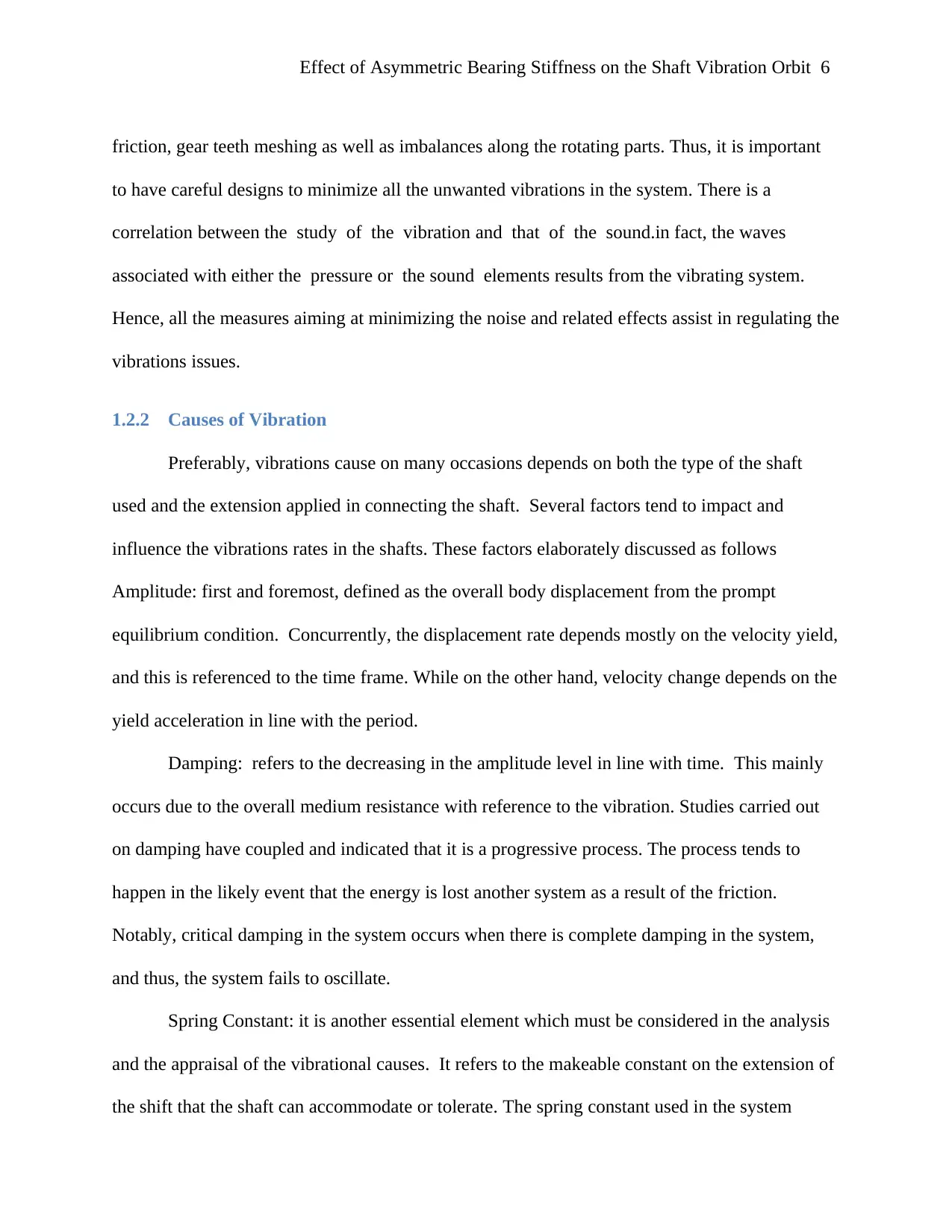
Effect of Asymmetric Bearing Stiffness on the Shaft Vibration Orbit 6
friction, gear teeth meshing as well as imbalances along the rotating parts. Thus, it is important
to have careful designs to minimize all the unwanted vibrations in the system. There is a
correlation between the study of the vibration and that of the sound.in fact, the waves
associated with either the pressure or the sound elements results from the vibrating system.
Hence, all the measures aiming at minimizing the noise and related effects assist in regulating the
vibrations issues.
1.2.2 Causes of Vibration
Preferably, vibrations cause on many occasions depends on both the type of the shaft
used and the extension applied in connecting the shaft. Several factors tend to impact and
influence the vibrations rates in the shafts. These factors elaborately discussed as follows
Amplitude: first and foremost, defined as the overall body displacement from the prompt
equilibrium condition. Concurrently, the displacement rate depends mostly on the velocity yield,
and this is referenced to the time frame. While on the other hand, velocity change depends on the
yield acceleration in line with the period.
Damping: refers to the decreasing in the amplitude level in line with time. This mainly
occurs due to the overall medium resistance with reference to the vibration. Studies carried out
on damping have coupled and indicated that it is a progressive process. The process tends to
happen in the likely event that the energy is lost another system as a result of the friction.
Notably, critical damping in the system occurs when there is complete damping in the system,
and thus, the system fails to oscillate.
Spring Constant: it is another essential element which must be considered in the analysis
and the appraisal of the vibrational causes. It refers to the makeable constant on the extension of
the shift that the shaft can accommodate or tolerate. The spring constant used in the system
friction, gear teeth meshing as well as imbalances along the rotating parts. Thus, it is important
to have careful designs to minimize all the unwanted vibrations in the system. There is a
correlation between the study of the vibration and that of the sound.in fact, the waves
associated with either the pressure or the sound elements results from the vibrating system.
Hence, all the measures aiming at minimizing the noise and related effects assist in regulating the
vibrations issues.
1.2.2 Causes of Vibration
Preferably, vibrations cause on many occasions depends on both the type of the shaft
used and the extension applied in connecting the shaft. Several factors tend to impact and
influence the vibrations rates in the shafts. These factors elaborately discussed as follows
Amplitude: first and foremost, defined as the overall body displacement from the prompt
equilibrium condition. Concurrently, the displacement rate depends mostly on the velocity yield,
and this is referenced to the time frame. While on the other hand, velocity change depends on the
yield acceleration in line with the period.
Damping: refers to the decreasing in the amplitude level in line with time. This mainly
occurs due to the overall medium resistance with reference to the vibration. Studies carried out
on damping have coupled and indicated that it is a progressive process. The process tends to
happen in the likely event that the energy is lost another system as a result of the friction.
Notably, critical damping in the system occurs when there is complete damping in the system,
and thus, the system fails to oscillate.
Spring Constant: it is another essential element which must be considered in the analysis
and the appraisal of the vibrational causes. It refers to the makeable constant on the extension of
the shift that the shaft can accommodate or tolerate. The spring constant used in the system
⊘ This is a preview!⊘
Do you want full access?
Subscribe today to unlock all pages.

Trusted by 1+ million students worldwide
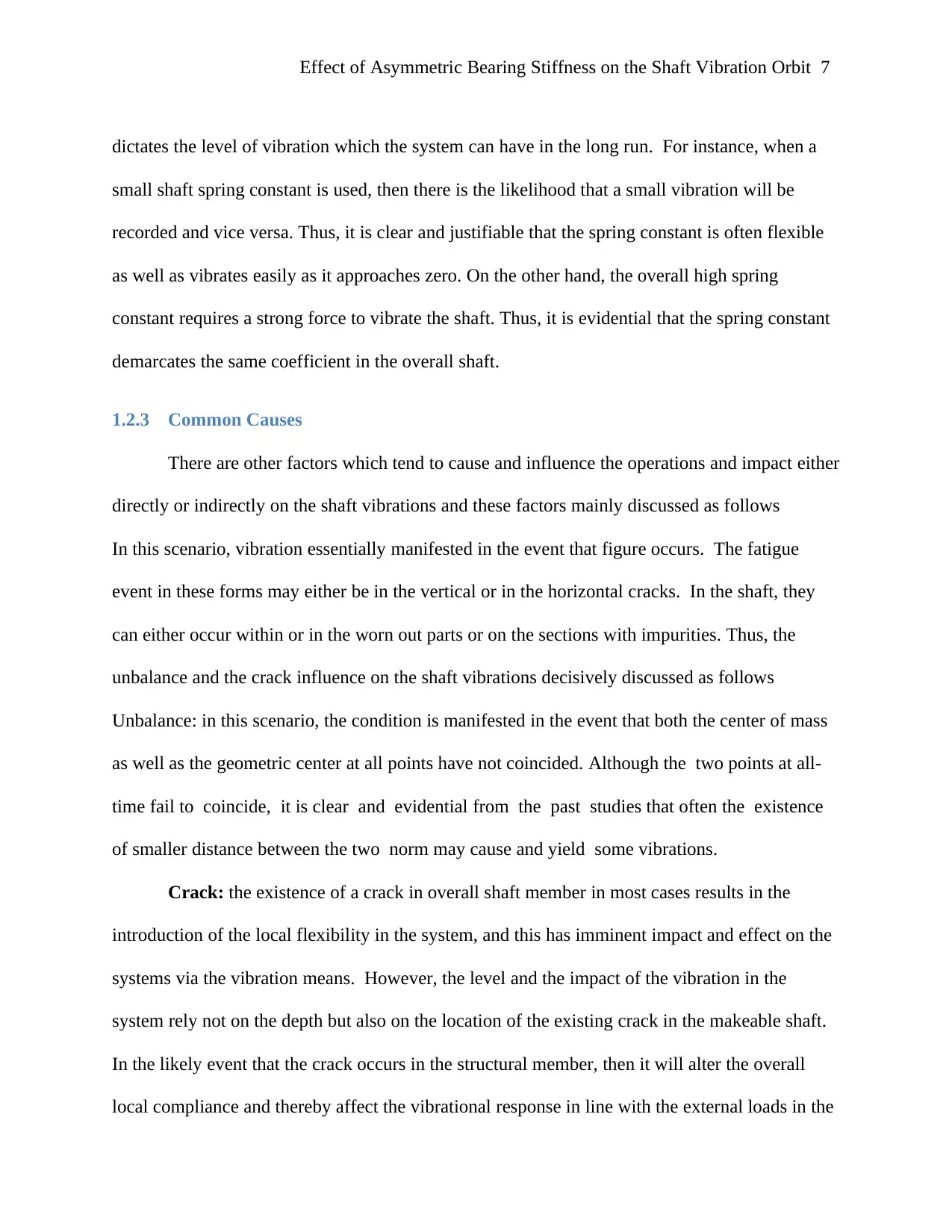
Effect of Asymmetric Bearing Stiffness on the Shaft Vibration Orbit 7
dictates the level of vibration which the system can have in the long run. For instance, when a
small shaft spring constant is used, then there is the likelihood that a small vibration will be
recorded and vice versa. Thus, it is clear and justifiable that the spring constant is often flexible
as well as vibrates easily as it approaches zero. On the other hand, the overall high spring
constant requires a strong force to vibrate the shaft. Thus, it is evidential that the spring constant
demarcates the same coefficient in the overall shaft.
1.2.3 Common Causes
There are other factors which tend to cause and influence the operations and impact either
directly or indirectly on the shaft vibrations and these factors mainly discussed as follows
In this scenario, vibration essentially manifested in the event that figure occurs. The fatigue
event in these forms may either be in the vertical or in the horizontal cracks. In the shaft, they
can either occur within or in the worn out parts or on the sections with impurities. Thus, the
unbalance and the crack influence on the shaft vibrations decisively discussed as follows
Unbalance: in this scenario, the condition is manifested in the event that both the center of mass
as well as the geometric center at all points have not coincided. Although the two points at all-
time fail to coincide, it is clear and evidential from the past studies that often the existence
of smaller distance between the two norm may cause and yield some vibrations.
Crack: the existence of a crack in overall shaft member in most cases results in the
introduction of the local flexibility in the system, and this has imminent impact and effect on the
systems via the vibration means. However, the level and the impact of the vibration in the
system rely not on the depth but also on the location of the existing crack in the makeable shaft.
In the likely event that the crack occurs in the structural member, then it will alter the overall
local compliance and thereby affect the vibrational response in line with the external loads in the
dictates the level of vibration which the system can have in the long run. For instance, when a
small shaft spring constant is used, then there is the likelihood that a small vibration will be
recorded and vice versa. Thus, it is clear and justifiable that the spring constant is often flexible
as well as vibrates easily as it approaches zero. On the other hand, the overall high spring
constant requires a strong force to vibrate the shaft. Thus, it is evidential that the spring constant
demarcates the same coefficient in the overall shaft.
1.2.3 Common Causes
There are other factors which tend to cause and influence the operations and impact either
directly or indirectly on the shaft vibrations and these factors mainly discussed as follows
In this scenario, vibration essentially manifested in the event that figure occurs. The fatigue
event in these forms may either be in the vertical or in the horizontal cracks. In the shaft, they
can either occur within or in the worn out parts or on the sections with impurities. Thus, the
unbalance and the crack influence on the shaft vibrations decisively discussed as follows
Unbalance: in this scenario, the condition is manifested in the event that both the center of mass
as well as the geometric center at all points have not coincided. Although the two points at all-
time fail to coincide, it is clear and evidential from the past studies that often the existence
of smaller distance between the two norm may cause and yield some vibrations.
Crack: the existence of a crack in overall shaft member in most cases results in the
introduction of the local flexibility in the system, and this has imminent impact and effect on the
systems via the vibration means. However, the level and the impact of the vibration in the
system rely not on the depth but also on the location of the existing crack in the makeable shaft.
In the likely event that the crack occurs in the structural member, then it will alter the overall
local compliance and thereby affect the vibrational response in line with the external loads in the
Paraphrase This Document
Need a fresh take? Get an instant paraphrase of this document with our AI Paraphraser
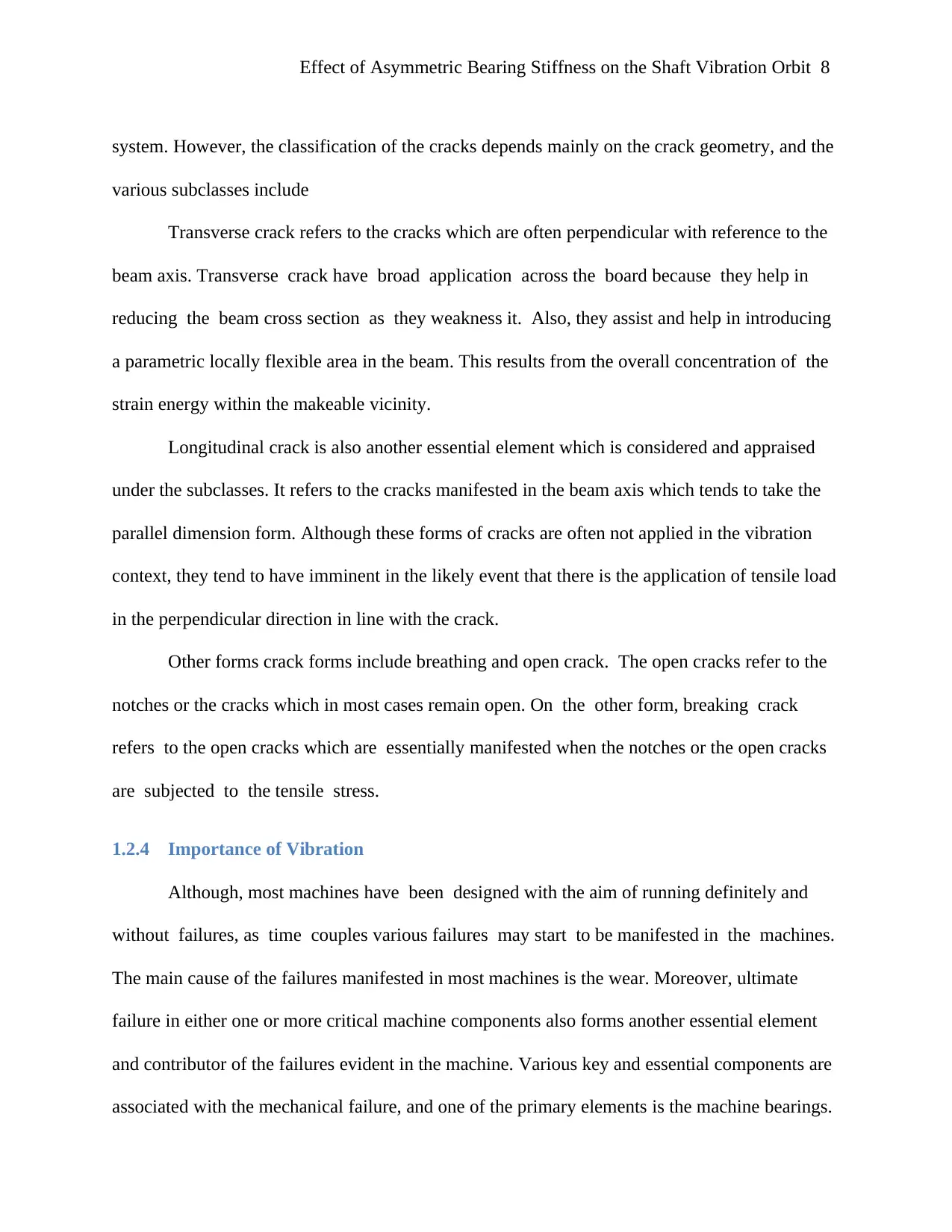
Effect of Asymmetric Bearing Stiffness on the Shaft Vibration Orbit 8
system. However, the classification of the cracks depends mainly on the crack geometry, and the
various subclasses include
Transverse crack refers to the cracks which are often perpendicular with reference to the
beam axis. Transverse crack have broad application across the board because they help in
reducing the beam cross section as they weakness it. Also, they assist and help in introducing
a parametric locally flexible area in the beam. This results from the overall concentration of the
strain energy within the makeable vicinity.
Longitudinal crack is also another essential element which is considered and appraised
under the subclasses. It refers to the cracks manifested in the beam axis which tends to take the
parallel dimension form. Although these forms of cracks are often not applied in the vibration
context, they tend to have imminent in the likely event that there is the application of tensile load
in the perpendicular direction in line with the crack.
Other forms crack forms include breathing and open crack. The open cracks refer to the
notches or the cracks which in most cases remain open. On the other form, breaking crack
refers to the open cracks which are essentially manifested when the notches or the open cracks
are subjected to the tensile stress.
1.2.4 Importance of Vibration
Although, most machines have been designed with the aim of running definitely and
without failures, as time couples various failures may start to be manifested in the machines.
The main cause of the failures manifested in most machines is the wear. Moreover, ultimate
failure in either one or more critical machine components also forms another essential element
and contributor of the failures evident in the machine. Various key and essential components are
associated with the mechanical failure, and one of the primary elements is the machine bearings.
system. However, the classification of the cracks depends mainly on the crack geometry, and the
various subclasses include
Transverse crack refers to the cracks which are often perpendicular with reference to the
beam axis. Transverse crack have broad application across the board because they help in
reducing the beam cross section as they weakness it. Also, they assist and help in introducing
a parametric locally flexible area in the beam. This results from the overall concentration of the
strain energy within the makeable vicinity.
Longitudinal crack is also another essential element which is considered and appraised
under the subclasses. It refers to the cracks manifested in the beam axis which tends to take the
parallel dimension form. Although these forms of cracks are often not applied in the vibration
context, they tend to have imminent in the likely event that there is the application of tensile load
in the perpendicular direction in line with the crack.
Other forms crack forms include breathing and open crack. The open cracks refer to the
notches or the cracks which in most cases remain open. On the other form, breaking crack
refers to the open cracks which are essentially manifested when the notches or the open cracks
are subjected to the tensile stress.
1.2.4 Importance of Vibration
Although, most machines have been designed with the aim of running definitely and
without failures, as time couples various failures may start to be manifested in the machines.
The main cause of the failures manifested in most machines is the wear. Moreover, ultimate
failure in either one or more critical machine components also forms another essential element
and contributor of the failures evident in the machine. Various key and essential components are
associated with the mechanical failure, and one of the primary elements is the machine bearings.
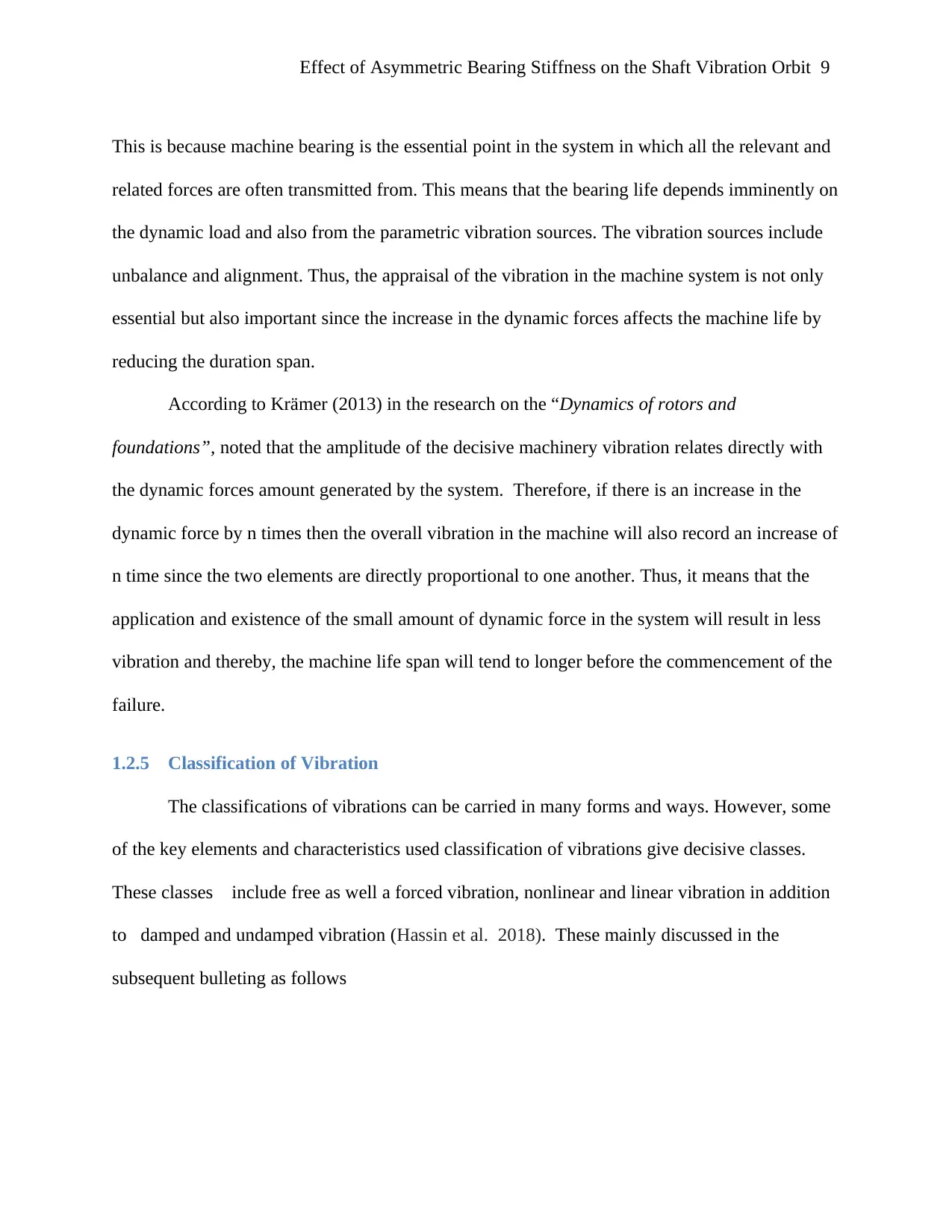
Effect of Asymmetric Bearing Stiffness on the Shaft Vibration Orbit 9
This is because machine bearing is the essential point in the system in which all the relevant and
related forces are often transmitted from. This means that the bearing life depends imminently on
the dynamic load and also from the parametric vibration sources. The vibration sources include
unbalance and alignment. Thus, the appraisal of the vibration in the machine system is not only
essential but also important since the increase in the dynamic forces affects the machine life by
reducing the duration span.
According to Krämer (2013) in the research on the “Dynamics of rotors and
foundations”, noted that the amplitude of the decisive machinery vibration relates directly with
the dynamic forces amount generated by the system. Therefore, if there is an increase in the
dynamic force by n times then the overall vibration in the machine will also record an increase of
n time since the two elements are directly proportional to one another. Thus, it means that the
application and existence of the small amount of dynamic force in the system will result in less
vibration and thereby, the machine life span will tend to longer before the commencement of the
failure.
1.2.5 Classification of Vibration
The classifications of vibrations can be carried in many forms and ways. However, some
of the key elements and characteristics used classification of vibrations give decisive classes.
These classes include free as well a forced vibration, nonlinear and linear vibration in addition
to damped and undamped vibration (Hassin et al. 2018). These mainly discussed in the
subsequent bulleting as follows
This is because machine bearing is the essential point in the system in which all the relevant and
related forces are often transmitted from. This means that the bearing life depends imminently on
the dynamic load and also from the parametric vibration sources. The vibration sources include
unbalance and alignment. Thus, the appraisal of the vibration in the machine system is not only
essential but also important since the increase in the dynamic forces affects the machine life by
reducing the duration span.
According to Krämer (2013) in the research on the “Dynamics of rotors and
foundations”, noted that the amplitude of the decisive machinery vibration relates directly with
the dynamic forces amount generated by the system. Therefore, if there is an increase in the
dynamic force by n times then the overall vibration in the machine will also record an increase of
n time since the two elements are directly proportional to one another. Thus, it means that the
application and existence of the small amount of dynamic force in the system will result in less
vibration and thereby, the machine life span will tend to longer before the commencement of the
failure.
1.2.5 Classification of Vibration
The classifications of vibrations can be carried in many forms and ways. However, some
of the key elements and characteristics used classification of vibrations give decisive classes.
These classes include free as well a forced vibration, nonlinear and linear vibration in addition
to damped and undamped vibration (Hassin et al. 2018). These mainly discussed in the
subsequent bulleting as follows
⊘ This is a preview!⊘
Do you want full access?
Subscribe today to unlock all pages.

Trusted by 1+ million students worldwide
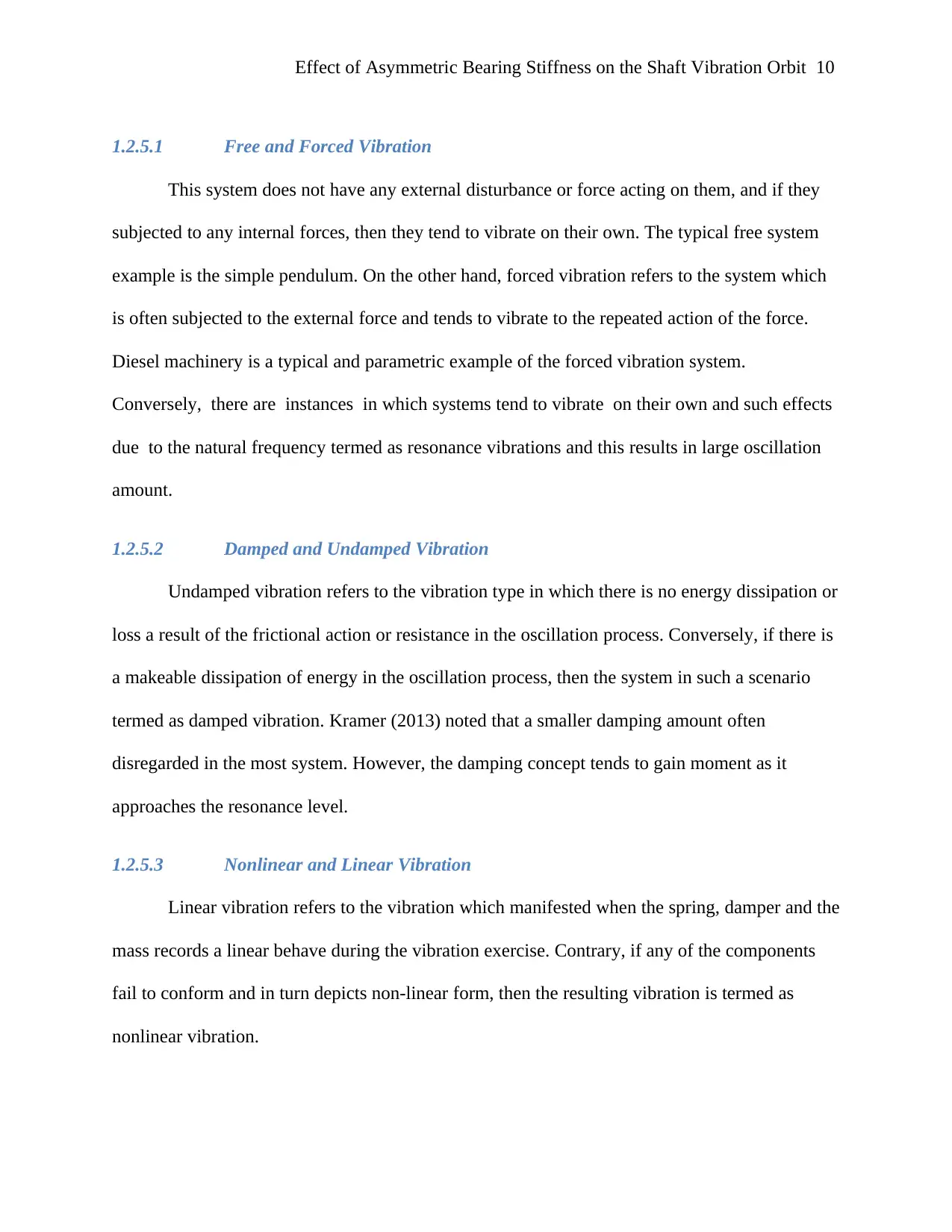
Effect of Asymmetric Bearing Stiffness on the Shaft Vibration Orbit 10
1.2.5.1 Free and Forced Vibration
This system does not have any external disturbance or force acting on them, and if they
subjected to any internal forces, then they tend to vibrate on their own. The typical free system
example is the simple pendulum. On the other hand, forced vibration refers to the system which
is often subjected to the external force and tends to vibrate to the repeated action of the force.
Diesel machinery is a typical and parametric example of the forced vibration system.
Conversely, there are instances in which systems tend to vibrate on their own and such effects
due to the natural frequency termed as resonance vibrations and this results in large oscillation
amount.
1.2.5.2 Damped and Undamped Vibration
Undamped vibration refers to the vibration type in which there is no energy dissipation or
loss a result of the frictional action or resistance in the oscillation process. Conversely, if there is
a makeable dissipation of energy in the oscillation process, then the system in such a scenario
termed as damped vibration. Kramer (2013) noted that a smaller damping amount often
disregarded in the most system. However, the damping concept tends to gain moment as it
approaches the resonance level.
1.2.5.3 Nonlinear and Linear Vibration
Linear vibration refers to the vibration which manifested when the spring, damper and the
mass records a linear behave during the vibration exercise. Contrary, if any of the components
fail to conform and in turn depicts non-linear form, then the resulting vibration is termed as
nonlinear vibration.
1.2.5.1 Free and Forced Vibration
This system does not have any external disturbance or force acting on them, and if they
subjected to any internal forces, then they tend to vibrate on their own. The typical free system
example is the simple pendulum. On the other hand, forced vibration refers to the system which
is often subjected to the external force and tends to vibrate to the repeated action of the force.
Diesel machinery is a typical and parametric example of the forced vibration system.
Conversely, there are instances in which systems tend to vibrate on their own and such effects
due to the natural frequency termed as resonance vibrations and this results in large oscillation
amount.
1.2.5.2 Damped and Undamped Vibration
Undamped vibration refers to the vibration type in which there is no energy dissipation or
loss a result of the frictional action or resistance in the oscillation process. Conversely, if there is
a makeable dissipation of energy in the oscillation process, then the system in such a scenario
termed as damped vibration. Kramer (2013) noted that a smaller damping amount often
disregarded in the most system. However, the damping concept tends to gain moment as it
approaches the resonance level.
1.2.5.3 Nonlinear and Linear Vibration
Linear vibration refers to the vibration which manifested when the spring, damper and the
mass records a linear behave during the vibration exercise. Contrary, if any of the components
fail to conform and in turn depicts non-linear form, then the resulting vibration is termed as
nonlinear vibration.
Paraphrase This Document
Need a fresh take? Get an instant paraphrase of this document with our AI Paraphraser
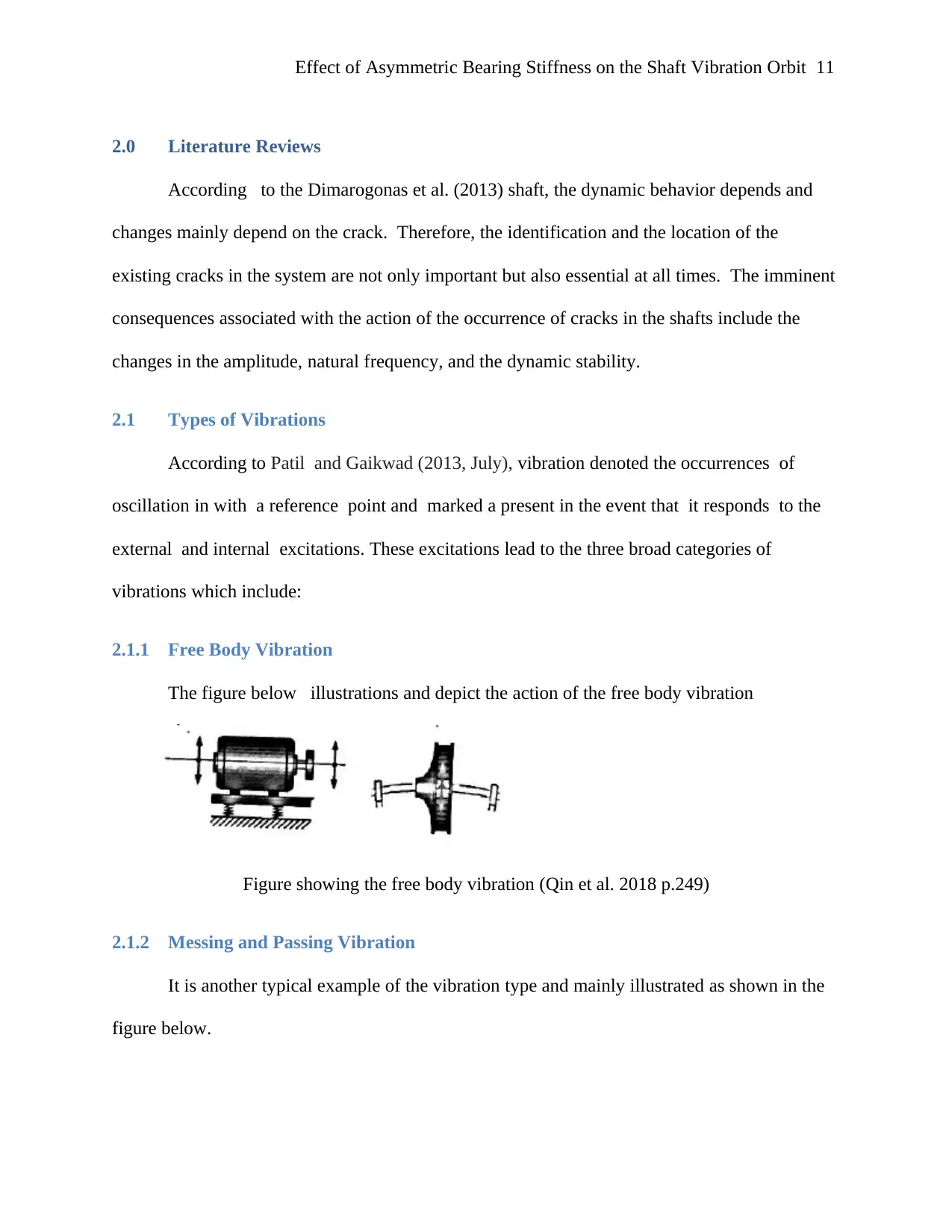
Effect of Asymmetric Bearing Stiffness on the Shaft Vibration Orbit 11
2.0 Literature Reviews
According to the Dimarogonas et al. (2013) shaft, the dynamic behavior depends and
changes mainly depend on the crack. Therefore, the identification and the location of the
existing cracks in the system are not only important but also essential at all times. The imminent
consequences associated with the action of the occurrence of cracks in the shafts include the
changes in the amplitude, natural frequency, and the dynamic stability.
2.1 Types of Vibrations
According to Patil and Gaikwad (2013, July), vibration denoted the occurrences of
oscillation in with a reference point and marked a present in the event that it responds to the
external and internal excitations. These excitations lead to the three broad categories of
vibrations which include:
2.1.1 Free Body Vibration
The figure below illustrations and depict the action of the free body vibration
Figure showing the free body vibration (Qin et al. 2018 p.249)
2.1.2 Messing and Passing Vibration
It is another typical example of the vibration type and mainly illustrated as shown in the
figure below.
2.0 Literature Reviews
According to the Dimarogonas et al. (2013) shaft, the dynamic behavior depends and
changes mainly depend on the crack. Therefore, the identification and the location of the
existing cracks in the system are not only important but also essential at all times. The imminent
consequences associated with the action of the occurrence of cracks in the shafts include the
changes in the amplitude, natural frequency, and the dynamic stability.
2.1 Types of Vibrations
According to Patil and Gaikwad (2013, July), vibration denoted the occurrences of
oscillation in with a reference point and marked a present in the event that it responds to the
external and internal excitations. These excitations lead to the three broad categories of
vibrations which include:
2.1.1 Free Body Vibration
The figure below illustrations and depict the action of the free body vibration
Figure showing the free body vibration (Qin et al. 2018 p.249)
2.1.2 Messing and Passing Vibration
It is another typical example of the vibration type and mainly illustrated as shown in the
figure below.
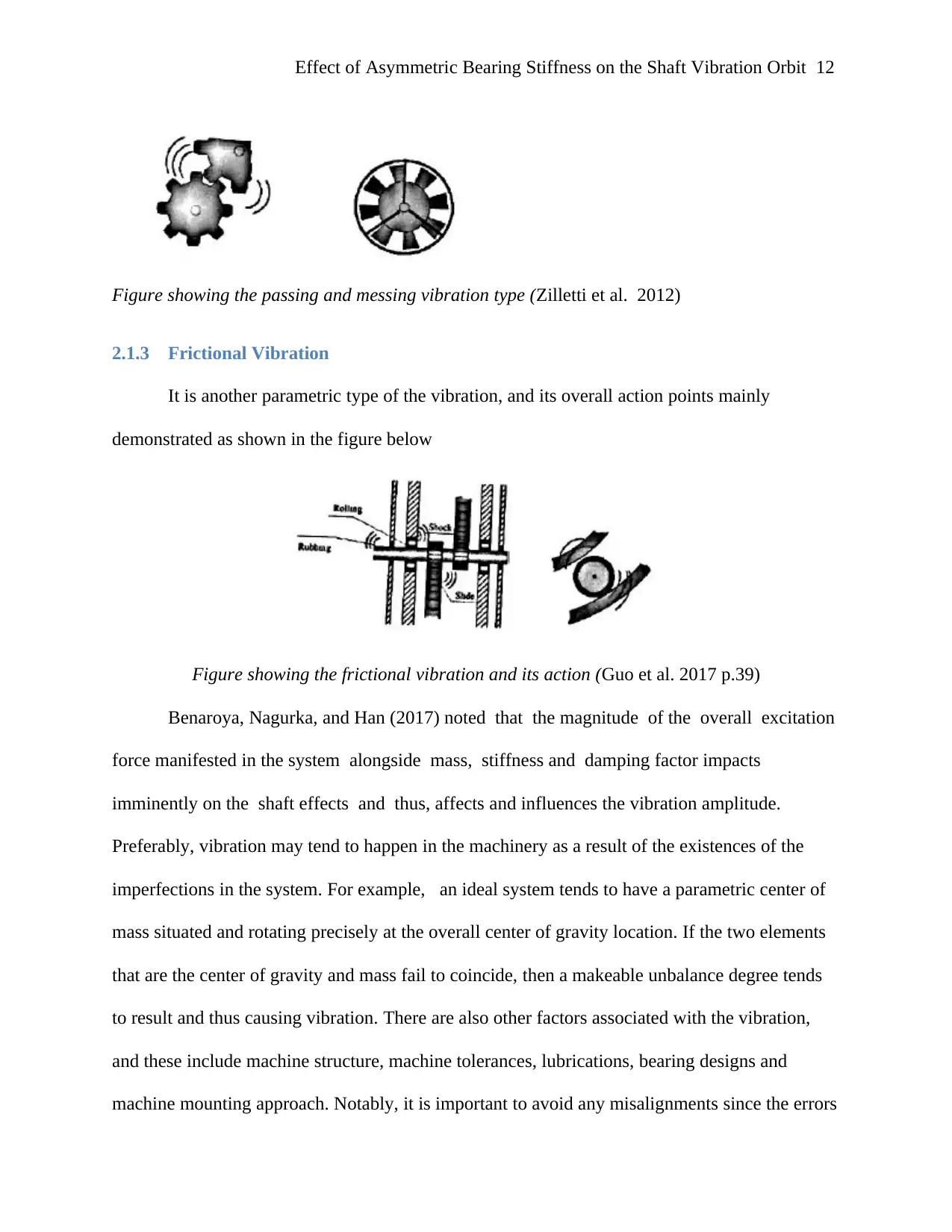
Effect of Asymmetric Bearing Stiffness on the Shaft Vibration Orbit 12
Figure showing the passing and messing vibration type (Zilletti et al. 2012)
2.1.3 Frictional Vibration
It is another parametric type of the vibration, and its overall action points mainly
demonstrated as shown in the figure below
Figure showing the frictional vibration and its action (Guo et al. 2017 p.39)
Benaroya, Nagurka, and Han (2017) noted that the magnitude of the overall excitation
force manifested in the system alongside mass, stiffness and damping factor impacts
imminently on the shaft effects and thus, affects and influences the vibration amplitude.
Preferably, vibration may tend to happen in the machinery as a result of the existences of the
imperfections in the system. For example, an ideal system tends to have a parametric center of
mass situated and rotating precisely at the overall center of gravity location. If the two elements
that are the center of gravity and mass fail to coincide, then a makeable unbalance degree tends
to result and thus causing vibration. There are also other factors associated with the vibration,
and these include machine structure, machine tolerances, lubrications, bearing designs and
machine mounting approach. Notably, it is important to avoid any misalignments since the errors
Figure showing the passing and messing vibration type (Zilletti et al. 2012)
2.1.3 Frictional Vibration
It is another parametric type of the vibration, and its overall action points mainly
demonstrated as shown in the figure below
Figure showing the frictional vibration and its action (Guo et al. 2017 p.39)
Benaroya, Nagurka, and Han (2017) noted that the magnitude of the overall excitation
force manifested in the system alongside mass, stiffness and damping factor impacts
imminently on the shaft effects and thus, affects and influences the vibration amplitude.
Preferably, vibration may tend to happen in the machinery as a result of the existences of the
imperfections in the system. For example, an ideal system tends to have a parametric center of
mass situated and rotating precisely at the overall center of gravity location. If the two elements
that are the center of gravity and mass fail to coincide, then a makeable unbalance degree tends
to result and thus causing vibration. There are also other factors associated with the vibration,
and these include machine structure, machine tolerances, lubrications, bearing designs and
machine mounting approach. Notably, it is important to avoid any misalignments since the errors
⊘ This is a preview!⊘
Do you want full access?
Subscribe today to unlock all pages.

Trusted by 1+ million students worldwide
1 out of 20
Your All-in-One AI-Powered Toolkit for Academic Success.
+13062052269
info@desklib.com
Available 24*7 on WhatsApp / Email
![[object Object]](/_next/static/media/star-bottom.7253800d.svg)
Unlock your academic potential
Copyright © 2020–2025 A2Z Services. All Rights Reserved. Developed and managed by ZUCOL.
